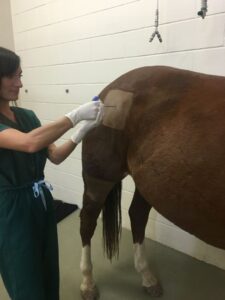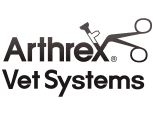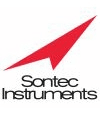Regenerative therapies for the treatment of joint disease and soft tissues injuries have been introduced in the field of equine surgery over the past decade. Specifically, equine veterinarians use stem cells, IRAP, and PRP to stimulate and work with the immune system to promote healing. In the horse, the focus of regenerative medicine lies primarily in the musculoskeletal system, originally for the treatment of over-strain tendon injuries. Regenerative medicine is an active area of ongoing research with many potential future applications in the treatment of a broad spectrum of disorders.
Regenerative therapies have been used in equine surgery for multiple indications including:
- Joint disease (osteoarthritis, synovitis, capsulitis)
- Tendon, ligament and meniscal injuries
- Laminitis
Osteoarthritis is a common cause of lameness in horses. Clinical signs include lameness, joint effusion (swelling), stiffness, or poor performance. The pain associated with osteoarthritis may result from cartilage damage within the joint, inflammation of the joint lining (synovitis), or associated subchondral bone pain.
Tendon and ligament injuries typically cause lameness of the affected limb, as well as focal swelling or heat, or sensitivity to palpation associated with the site of injury.
Your veterinarian can help you decide whether your horse will benefit from one of the regenerative therapies. Determination of which biologic therapy is most appropriate will depend on several factors, including the primary disease process, chronicity of disease, and response to previous treatments (e.g. nonsteroidal anti-inflammatory medications, intra-articular corticosteroid injections). Your veterinarian may perform the following in order to determine the appropriate therapy for your horse:
- Physical examination including musculoskeletal palpation
- Lameness evaluation, including flexion tests and diagnostic anesthesia (perineural or intra-articular) in order to localize the source of lameness
- Radiographs to assess bony structures
- Ultrasound to examine soft tissue structures, including ligaments and tendons, intra-articular structures or the joint capsule for presence of synovitis or capsulitis
- Surgical arthroscopy of the joint may be indicated and beneficial to better determine prognosis
Interleukin-1 receptor antagonist protein (IRAP)
Interleukin-1 receptor antagonist protein, also referred to as autologous conditioned serum, was developed to counteract the effects of the cytokine interleukin-1 produced in sites of inflammation, such as a joint with osteoarthritis. Trauma results in the release of inflammatory mediators including IL-1 as well as other cytokines, which may potentiate further damage and progression of disease. Interleukin-1 receptor antagonist protein works to counteract the destructive effects of IL-1 in sites of inflammation by blocking IL-1 receptors in the joint to break the cycle of inflammation.
Processing of IRAP involves taking a blood sample from your horse into a special syringe to stimulate production of IL-1 receptor antagonist protein. The blood is incubated in the syringe for 24 hours, then centrifuged, and the plasma is separated and frozen for future injection. IRAP is typically injected every 7 to 14 days for 2 to 5 treatments depending on the primary disease process. The IRAP samples are stored in a -80◦C freezer until they are used.
Specific indications for IRAP therapy in equine surgery are for treatment of moderate osteoarthritis, synovitis or capsulitis, or in horses that do not respond following intra-articular anti-inflammatory medications such as corticosteroids.
Platelet rich plasma (PRP)
Platelet rich plasma is a concentration of platelets used to provide growth factors secreted by the platelets to a site of injury. The growth factors act to enhance healing by improving access of healthy inflammatory cells to the tissue through formation of new blood vessels and connective tissue, and regeneration of skin.
Processing of PRP also involves taking a blood sample, which is centrifuged to separate the platelets themselves, which then release growth factors upon activation. Collection of blood and processing of plasma to obtain platelet rich plasma takes approximately 30 minutes prior to injection. Several different PRP kits are available commercially, and depending on the processing method used, the number of platelets and cell purity (e.g. presence of white blood cells) within the final concentrate may vary.
The most common indication for use of PRP is in the treatment of tendon and ligament injuries. Recently, some veterinarians have also used PRP intra-articularly to treat osteoarthritis, as well as to enhance bone and wound healing.

Stem cell therapy
Mesenchymal stem cells (MSCs) are defined by their ability to differentiate into multiple cell lines (osteogenic, chondrogenic, and lipogenic) to yield different cell types including tendon, ligament, bone, cartilage, and muscle. The most common source of MSCs in equine surgery is bone marrow, which may be harvested from the sternum or tuber coxae in the horse (Figures 1 and 2). In addition to bone marrow, the other common clinically used source of MSCs in horses is adipose tissue, which is often harvested from the tail head. Adipose tissue may yield MSCs which are isolated and cultured, or processed through digestion and flotation to yield a substance called ‘stromal vascular fraction,’ which contains other cell types in addition to MSCs. Other sources of MSCs in the body include umbilical cord blood, amniotic tissue, dental pulp, as well as synovial fluid and the synovial lining of joints in very low numbers.
Following harvesting, bone marrow aspirate is cultured sterilely in a laboratory to isolate and expand mesenchymal stem cells, which takes approximately 2 to 4 weeks. Typical dose ranges are from 10 to 20 million stem cells per joint or site.
Stem cells have been injected intra-articularly to treat osteoarthritis, as well as tendon and ligament injuries and laminitis. Research is ongoing to determine the many applications for stem cells in equine surgery but results are promising.
Infection or ‘flare’ are uncommon complications following injection of regenerative therapies. As with any joint injection, it is important to monitor carefully for signs of infection (heat, swelling, or increased lameness) following injection of regenerative therapies.
Following evaluation and continued treatment, your regular veterinarian will be able to provide specific instructions for exercise and rehabilitation, depending on the primary disease being treated. Typically stall rest with a controlled exercise and rehabilitation program is recommended following implementation of biologic therapies. Prognosis for return to previous level or future athleticism will also depend upon the specific diagnosis and chronicity of the disease process.
Development of regenerative therapies (IRAP, PRP, stem cells) have allowed for the treatment of equine musculoskeletal disorders that may previously have limited performance. Consult your veterinarian to determine if your horse would benefit from one of these therapies.













